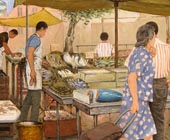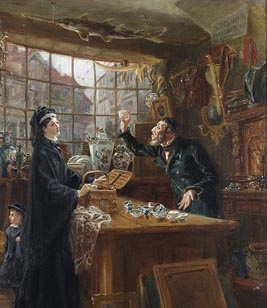 How many times have you seen products being promoted as “local” and yet it seems just as industrial as any other product? The label “local” has become just another marketing tool to sell you more. Some people define local rather arbitrarily as products within a fifty or sixty-mile radius from where they live.
How many times have you seen products being promoted as “local” and yet it seems just as industrial as any other product? The label “local” has become just another marketing tool to sell you more. Some people define local rather arbitrarily as products within a fifty or sixty-mile radius from where they live.
What really makes a product local? A truly local product definitely comes from a region that is close by. It involves an economy that favors local communities and their products. However, geography is not the only determining or even the most important factor in producing “local” goods.
Real local production involves several dynamic elements: the intensive development of an amazing variety of local resources, the pressure to turn out quality work, and the fruitful and direct interaction of consumer and producer who mutually adjust demand for products to conform to local needs. If a region is suited to the production of nice red wines, a local producer will know how to make maximum use of there resources by striving to produce a fine wine that is the pride of the region.
But true regionalism is not only an understanding of the land and resources.  The human element is the most important element. What defines a region is the development of good habits and therefore virtues by the inhabitants as they adapt to the reality of the place.
The human element is the most important element. What defines a region is the development of good habits and therefore virtues by the inhabitants as they adapt to the reality of the place.
People practice virtues in different ways. The land and climate often favors these practices. In cold regions, for example, people are more hardy and resourceful. In sunny climes, they may be more festive and artistic. The distinctive way of practicing virtue in a region sets the tone for a way of life and the crafting of products. It leads to the forming of wholesome customs.
Healthy regionalism is a very stable order of things. In an atmosphere deeply imbued with this spirit, everyone feels at ease in his home and does not needlessly destroy old habits but prefers to adapt or add to them. This order is customary and breathes freely around those things that are permanent.
At the same time, these habits and customs do not stagnate since one is always striving to make them better. This order cultivates habits; it changes by refining not overthrowing. Souls like this, thirsting for habits, are what make regionalism thrive. That is what makes things truly local.
 If understood in this way, local is not a marketing label but a way of life. Real local products are not fleeting sensations but ever-improving items often produced over generations. Products like this taste better, last longer or mean more to us. Economies like this tend to be temperate and balanced.
If understood in this way, local is not a marketing label but a way of life. Real local products are not fleeting sensations but ever-improving items often produced over generations. Products like this taste better, last longer or mean more to us. Economies like this tend to be temperate and balanced.
* * *
Do you know a truly local product in your area that you would like to share with readers? Perhaps some company that has been around for generations? Or something that is the pride of your region?


